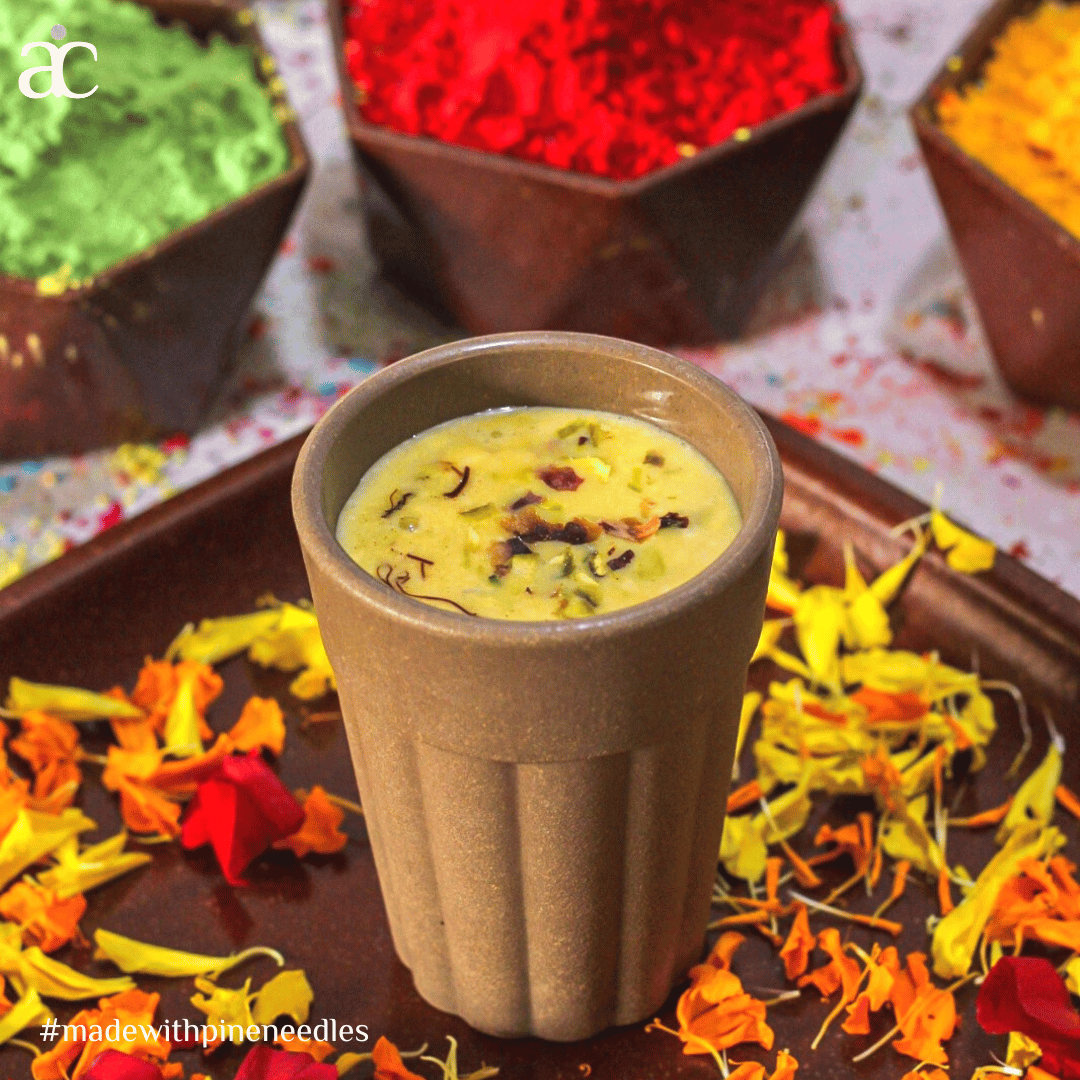Holi, the vibrant festival of colors, is a time for joy, laughter, and community. But amidst the revelry, it's crucial to be mindful of our environmental impact. Here's how you can celebrate a vibrant and sustainable Holi this Monday, 25 Mar, 2024
Ditch the harsh chemical-laden colors and opt for natural alternatives. Here are some options:
-
Homemade: Create vibrant colors using ingredients like turmeric, beetroot powder, sandalwood, and flower petals.
-
Organic: Purchase certified organic colors made with natural ingredients and plant-based dyes.
-
Dry Colors: Use dry colors instead of wet pastes, which are easier to clean and require less water.
Reduce Waste
Minimize your environmental footprint by adopting these practices:
-
Reusable Gulaal Pouches: Use fabric pouches or recycled paper bags instead of plastic packets for throwing colors.
-
Water Conservation: Play responsibly with water. Use small buckets instead of hoses and avoid wastage.
-
Minimal Decorations: Opt for eco-friendly decorations made with recycled materials or natural elements like leaves and flowers.
Sustainable Cleanup
Leave the environment as you found it by following these tips:
-
Biodegradable Colors: Choose colors that are biodegradable and break down naturally, reducing soil and water pollution.
-
Composting: Collect leftover dry colors and compost them in your garden.
-
Responsible Disposal: Dispose of wet colors and water responsibly, avoiding drains or waterways.
Spread Awareness
Encourage others to celebrate sustainably by:
-
Leading by Example: Share your sustainable practices with friends and family.
-
Educate others: Talk about the environmental impact of conventional Holi celebrations.
-
Support eco-friendly initiatives: Participate in community clean-up drives or support organizations promoting sustainable Holi practices.
Additional Tips
- Use public transport or carpool to reduce your carbon footprint.
- Avoid using single-use plastic items like plates and cups.
- Opt for locally-sourced food and drinks to reduce transportation emissions.
- Celebrate within reasonable hours to respect your neighbors and minimize noise pollution.
Beyond Sustainability
Remember, Holi is more than just colors. It's about celebrating love, unity, and the triumph of good over evil. Celebrate the spirit of Holi with compassion, inclusivity, and respect for all beings.
Reduce Waste:
Ditch the Plastic: Embrace Reusable Gulaal Pouches for a Sustainable Holi
Holi, the vibrant festival of colors, is a time for joyous expression and community connection. But amidst the laughter and revelry, plastic waste from single-use gulaal pouches poses a significant environmental concern. This year, let's break free from plastic and celebrate with reusable gulaal pouches.
Why Ditch Plastic Pouches?
-
Plastic pollution: Billions of plastic gulaal pouches are used and discarded during Holi, contributing to environmental pollution and harming wildlife.
-
Landfill burden: These non-biodegradable pouches end up in landfills, taking centuries to decompose and leaching harmful chemicals into the soil.
-
Health risks: Burning or improperly disposing of plastic pouches releases toxic fumes, posing health risks to both humans and the environment.
Embrace the Reusable Revolution:
-
Sustainable materials: Opt for pouches made from natural fabrics like cotton, jute, or hemp, which are biodegradable and compostable.
-
Multiple uses: Reusable pouches can be filled and refilled year after year, reducing waste and saving money.
-
Stylish options: Choose from a variety of vibrant colors and designs to add a touch of personal flair to your Holi celebration.
-
Encourages responsibility: Using reusable pouches sets a positive example, promoting environmental awareness and responsible celebration practices.
Tips for Using Reusable Pouches:
-
Fill them thoughtfully: Only fill pouches with the amount of gulaal you need, avoiding overconsumption.
-
Easy handling: Choose pouches with secure closures for convenient use and to prevent spillage.
-
Cleaning and storage: Wash pouches after use and store them dry for future celebrations.
-
Spread the word: Encourage others to adopt reusable pouches and contribute to a cleaner, greener Holi.
Going beyond Pouches:
-
Embrace dry colors: Minimize water usage by opting for dry color play whenever possible.
-
Sustainable disposal: Dispose of leftover colors responsibly, avoiding drains or waterways.
-
Support eco-friendly initiatives: Look for organizations promoting sustainable Holi practices and consider contributing or volunteering.
Remember, small changes can create a big impact. By choosing reusable gulaal pouches and adopting other sustainable practices, we can celebrate Holi with joy and vibrancy while protecting our planet for future generations. Let's make this Holi a celebration of color, community, and environmental responsibility!
This paragraph highlights the importance of using reusable gulaal pouches for a sustainable Holi, explaining the environmental benefits and providing tips for implementation.
Holi and Water Conservation: Playing Responsibly for a Vibrant Future
Holi, the festival of colors, evokes images of playful water fights and vibrant laughter. However, amidst the joyful chaos, it's essential to remember the precious resource behind it all - water. While water fuels the celebratory spirit, its overindulgence can create significant environmental and social challenges. Let's explore how we can embrace water conservation and celebrate a responsible and vibrant Holi:
Understanding the Impact:
-
Water scarcity: Many regions already face water scarcity, and excessive use during festivals exacerbates the problem.
-
Water pollution: Unmanaged wastewater from Holi celebrations can contaminate water bodies, impacting aquatic life and human health.
-
Resource strain: Treating and supplying large amounts of water for temporary usage strains resources that could be directed towards essential needs.
Simple Steps, Big Impact:
-
Embrace dry colors: Opt for dry, plant-based colors that don't require water for throwing.
-
Playful minimalism: Limit water use during playtime. Use smaller buckets instead of hoses, and prioritize dry color play.
-
Designated zones: Confine water-based activities to specific areas, minimizing the overall area needing cleaning.
-
Efficient cleanup: Use minimal water for cleanup. Consider using brooms and dry cloths for initial color removal, followed by targeted water usage for stubborn areas.
-
Spread awareness: Share these tips with friends and family, making water conservation a collective effort.
Beyond the Bucket:
-
Promote responsible water usage throughout the year: Encourage water-saving practices like shorter showers, fixing leaky faucets, and rainwater harvesting.
-
Support sustainable initiatives: Look for organizations promoting water conservation and responsible Holi celebrations, and consider volunteering or contributing.
-
Celebrate mindful joy: Shift the focus from excessive water use to the true essence of Holi – the spirit of unity, love, and community.
Remember, every drop counts. By adopting these simple practices and spreading awareness, we can celebrate Holi with joy and color while ensuring a vibrant future for ourselves and the planet. Let's make this Holi a celebration of both festivity and responsibility!
This explanation emphasizes the crucial role of water conservation in ensuring a sustainable and joyful Holi.
Minimal Decorations: Embracing Simplicity for a Joyful Holi
Holi, with its vibrant colors and exuberant energy, often invites grand decorations. However, this year, consider embracing a minimal approach, celebrating with simplicity and sustainability in mind. Here's why and how:
Why Go Minimal?
-
Reduce waste: Excessive decorations often end up as waste, filling landfills and contributing to environmental pollution.
-
Save money: Opting for minimal décor saves resources and allows you to allocate funds towards other aspects of the celebration.
-
Focus on the essence: Minimalism allows the true spirit of Holi – joy, community, and connection – to shine through without distractions.
-
Encourage mindfulness: A simpler environment fosters a more mindful celebration, focusing on the true meaning of the festival.
Tips for Minimal Decorations:
-
Natural elements: Let nature do the decorating! Use leaves, flowers, and branches to create simple yet beautiful centerpieces and accents.
-
Upcycled treasures: Give new life to old items like bottles, jars, and fabrics by transforming them into unique decorations.
-
Handmade touches: Put your creativity to work! Fold origami decorations, craft colorful garlands from recycled paper, or paint designs on fabric scraps.
-
Less is more: Emphasize quality over quantity. Choose a few statement pieces that resonate with the spirit of Holi rather than cluttering the space.
-
Focus on lighting: Create a warm and inviting ambiance with soft, natural light or string lights made from recycled materials.
Beyond Decorations:
-
Sustainable colors: Opt for organic, biodegradable colors to minimize environmental impact.
-
Responsible practices: Minimize water usage during celebrations and choose eco-friendly disposal methods for leftover colors.
-
Community connections: Celebrate with loved ones, fostering meaningful interactions and strengthening bonds.
-
Spread awareness: Inspire others to embrace a simpler, more sustainable approach to Holi celebrations.
Remember, simplicity isn't about deprivation, but about mindful celebration.
By reducing our environmental footprint and focusing on the true essence of Holi, we can create a meaningful and joyful experience for all. Let's celebrate responsibly and leave a lasting positive impact with minimal decorations and maximum joy!
This paragraph explains the benefits of adopting a minimal decoration approach for Holi, offering tips and ideas for creating a beautiful and sustainable celebration.
Sustainable Cleanup:
Biodegradable Colors: Painting a Vibrant Future for Holi (Revised)
Holi, the festival of colors, bursts with vibrant hues and joyous energy. But amidst the revelry, the environmental impact of traditional, chemical-laden colors cannot be ignored. This year, let's celebrate responsibly and choose biodegradable colors to paint a brighter future for both color and planet.
Nature's Palette: Biodegradable colors come alive with the power of nature, using pigments derived from plants like beetroot, turmeric, and flower petals. Unlike their synthetic counterparts, these colors:
-
Embrace decomposition: They gracefully break down into harmless organic matter, enriching the soil instead of polluting it. Imagine vibrant colors fading not into toxic stains, but into nutrients that nourish the earth.
-
Celebrate without compromise: They come in a dizzying array of stunning shades, offering every color of the rainbow for your joyous celebration. Let the earth's natural brilliance illuminate your Holi experience.
-
Protect sensitive skin: Free from harsh chemicals and heavy metals, they are gentler on your skin, allowing you to celebrate with carefree laughter and vibrant splashes, not irritation.
Beyond Personal Benefits:
Opting for biodegradable colors goes beyond individual choices; it's a collective declaration of responsibility:
-
Sparkling rivers, not polluted streams: With colors dissolving harmlessly, waterways remain pristine for humans and aquatic life alike. Holi's joy echoes not just in laughter, but in the health of our precious water resources.
-
Flourishing soil, not chemical burdens: Decomposed pigments act as natural fertilizers, nurturing the earth instead of burdening it. Our celebration leaves a legacy of life, not pollution.
-
Building a vibrant future: Choosing biodegradable colors sets a powerful example, inspiring others to join the movement and leave a positive impact for generations to come.
This Holi, let's go beyond the colors and paint a picture of responsibility. Choose nature's brushstrokes with biodegradable hues. Celebrate with the joyous symphony of life, ensuring a vibrant future for both the colors and the planet they adorn.
This revised paragraph emphasizes the positive ecological impact of biodegradable colors, highlighting their benefits for soil health, water quality, and environmental sustainability. It also connects personal choices to a larger vision of responsible celebration and a vibrant future.

Composting: Turning Kitchen Scraps into Garden Gold
Ever wonder what to do with food scraps, eggshells, and yard trimmings besides sending them to the landfill? The answer lies in the magical process of composting! This natural phenomenon transforms organic waste into rich, nutrient-filled soil amendment, perfect for nurturing your garden or houseplants.
Think of composting as Mother Nature's recycling program. By creating the right environment, you encourage tiny decomposers like bacteria, fungi, and worms to break down organic matter. This decomposition process results in crumbly, dark-colored compost, teeming with beneficial microorganisms and nutrients like nitrogen, phosphorus, and potassium.
Adding compost to your soil offers a wealth of benefits:
-
Improved soil fertility: Compost provides essential nutrients, acting as a natural fertilizer that helps plants thrive.
-
Enhanced water retention: Compost improves soil structure, allowing it to hold moisture more effectively, reducing watering needs.
-
Reduced waste: Composting diverts organic waste from landfills, decreasing methane emissions and contributing to a more sustainable waste management system.
-
Booming soil life: The microorganisms in compost enrich the soil ecosystem, promoting healthy plant growth and resilience.
Getting started with composting is easier than you might think! Here are the basics:
-
Set up a compost bin: You can purchase a bin or build your own using wood, wire mesh, or even recycled materials.
-
Layer your ingredients: Alternate "brown" materials like dry leaves and shredded paper with "green" materials like food scraps and coffee grounds.
-
Maintain moisture and air: Ensure your compost pile stays moist but not soggy, and provide adequate air circulation.
-
Turn your pile regularly: This helps aerate the compost and encourages decomposition.
-
Patience is key: Depending on the size and conditions, your compost may take a few months to fully mature.
By embracing composting, you're not just cleaning your kitchen scraps, you're creating a valuable resource for your garden and contributing to a healthier planet. So, embrace the magic of decomposition and turn your waste into garden gold!
Beyond the Celebration: Responsible Disposal for a Sustainable Holi
Holi, the vibrant festival of colors, brings communities together in laughter, joy, and vibrant hues. But with the revelry comes the responsibility of responsible disposal, ensuring a cleaner environment and a brighter future for everyone. Here's how you can prioritize responsible practices after your Holi celebrations:
Understand Your Waste:
-
Biodegradable Colors: These colors, made from plant-based materials, can be composted in your garden or designated community composting areas. Check local guidelines for proper disposal options.
-
Non-Biodegradable Colors: Unfortunately, these colors require special handling due to their chemical content. Avoid drains and waterways, and look for designated hazardous waste disposal facilities in your area.
-
Wet Colors: These require more effort than dry colors. Avoid washing them directly into drains or waterways. Consider filtering the water through layers of cloth or sand before releasing it, and compost any collected color residue if biodegradable.
Choose the Right Disposal Methods:
-
Composting: Biodegradable colors and leftover natural decoration materials like leaves and flowers can be composted. Make sure to check local regulations and follow proper composting techniques.
-
Designated Disposal Zones: Look for community-organized collection points for non-biodegradable colors and other non-compostable waste. Follow instructions provided by authorities.
-
Hazardous Waste Facilities: Dispose of non-biodegradable colors and other hazardous materials (like some cleaning products) at designated hazardous waste facilities. Never dump them in regular trash bins.
Minimize Waste Generation:
-
Embrace dry colors: Whenever possible, opt for dry, natural colors to minimize water usage and simplify cleanup.
-
Reusable alternatives: Use reusable gulaal pouches instead of single-use plastic ones. Encourage others to do the same.
-
Sustainable decorations: Minimize decorations or choose natural elements like leaves and flowers that can be composted afterwards.
Spread Awareness and Action:
-
Educate your community: Share information about responsible disposal practices with friends, family, and neighbors.
-
Organize clean-up drives: Join or initiate community clean-up drives to ensure a clean and healthy environment after the celebrations.
-
Support eco-friendly initiatives: Look for organizations promoting sustainable Holi practices and consider volunteering or contributing to their efforts.
Remember, every responsible action, from choosing the right colors to using proper disposal methods, contributes to a cleaner and healthier environment for everyone. Let's celebrate Holi with joy and vibrancy while ensuring a sustainable future for ourselves and generations to come.
Some popular FAQ topics about Holi include:
-
Date and time of Holi: This varies each year based on the lunar calendar.
-
Origins and history of Holi: Explore the legends and mythology behind the festival.
-
Significance of colors and traditions: Understand the meaning behind different colors and customs.
-
How to celebrate Holi safely and sustainably: Learn about eco-friendly practices and responsible play.
-
What to wear and eat during Holi: Discover traditional attire and popular Holi delicacies.
-
Regional variations of Holi: Explore how the festival is celebrated differently in different parts of India and the world.
2. Do you have specific questions about a particular aspect of Holi?
If you have a specific question that isn't covered in the topics above, feel free to ask me directly. The more details you provide, the better I can understand your needs and provide a relevant answer.
3. Are you looking for general information or something more specific?
Let me know if you're looking for a broad overview of Holi or if you have a specific question about something you encountered while researching the festival.







